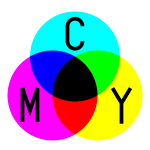Colour theory
Color theory is a guide color mixing and the visual effects of color combinations.
There are also definitions (or categories) of colors based on the color wheel: primary color, secondary and tertiary colors.[1] Color theory principles first appeared in the writings of Leone Battista Alberti (c. 1435) and the notebooks of Leonardo da Vinci (c. 1490).


The foundations of pre-20th-century color theory were built around "pure" or ideal colors, as sensory experiences rather than the physical world. This has led to a number of inaccuracies in the color theory principles.
There is a difference between the behaviour of light mixtures, called additive color mixing, and the behavior of paint, ink, dye, or pigment mixtures, called subtractive color mixing. The absorption of light by material substances follows different rules from the perception of light by the eye.
A second problem is the failure to describe the important effects of strong light. The appearance of colors reflected from a surface (such as paints or inks) is not the same as mixed colors of light. "Colors" such as browns or ochres cannot appear in mixtures of light. A strong lightness contrast between a mid-valued yellow paint and a surrounding bright white makes the yellow appear to be green or brown, while a strong brightness contrast between a rainbow and the surrounding sky makes the yellow in a rainbow appear to be a fainter yellow, or white.
Another problem is the tendency to describe color too simply, for example as a contrast between "yellow" and "blue". Most color effects are due to contrasts on the attributes that define all colors:
- Value, (light vs. dark, or white vs. black),
- Chroma, [saturation, strength, intensity] (intense vs. dull), and
- Hue (e.g. the name of the color family: red, yellow, green, cyan, blue and magenta).
Thus, the visual impact of "yellow" vs. "blue" hues in visual design depends on the relative lightness and saturation of the hues.
Many color theorists have said that three "pure" primary colors can mix all possible colors. They think any failure of paints or inks to match this ideal performance is due to the impurity or imperfection of the colorants. But any three real "primary" colors of light, paint or ink can mix only a limited range of colors, which is always smaller than the full range of colors we can see.[2][3]
Related pages
changeReferences
change- ↑ Dekel, Gil (2016). "RGB and CMYK Colour [sic] systems". Retrieved 2016-06-24.
- ↑ Humans can perceive over 2.8 million different hues. Pointer M.R. & Attridge G.G. 1998. The number of discernible colors. Color Research and Application, 23 (1), pp. 52–54.
- ↑ Hard, A. & Sivik, L. (2001). "A theory of colors in combination – A descriptive model related to the NCS color-order system". Color Research and Application, 26 (1), pp. 4–28.